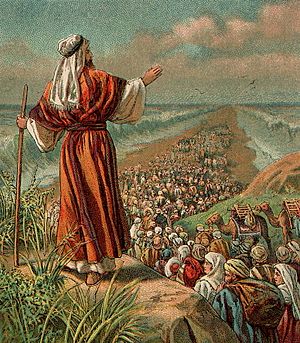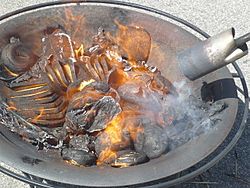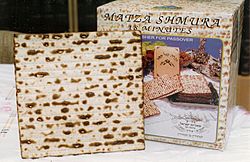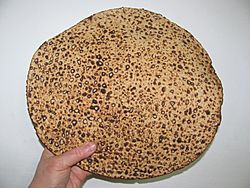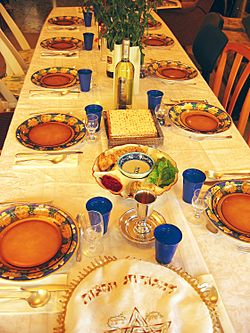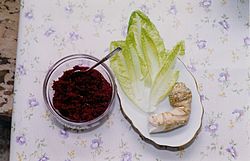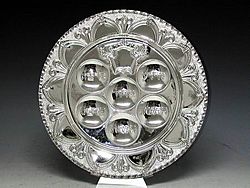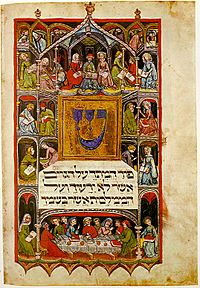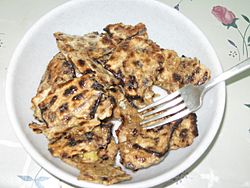Passover facts for kids
Quick facts for kids Passover |
|
|---|---|
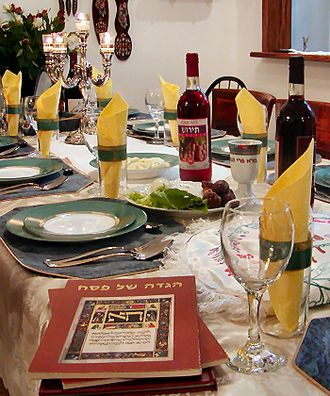 |
|
| Official name | Hebrew: פסח (Pesach) |
| Observed by | Jews, Samaritans, some Christians including Malayali Nasrani Christians, Knanaya and followers of Messianic Judaism. |
| Type | One of the Three Pilgrim Festivals |
| Significance | Celebrates the Exodus, the freedom from slavery of the Children of Israel from ancient Egypt that followed the Ten Plagues. Beginning of the 49 days of Counting of the Omer |
| Celebrations | In Jewish practice, one or two festive Seder meals – first two nights; in the times of the Temple in Jerusalem, the Passover sacrifice. In Samaritan practice, men gather for a religious ceremony on mount Gerizim that includes the ancient cow Sacrifice.il (7th day) |
| Begins | 15th day of Nisan |
| Ends | 21st day of Nisan in Israel, and among some liberal Diaspora Jews; 22nd day of Nisan outside of Israel among more traditional Diaspora Jews. |
| Date | Lua error in Module:Wikidata at line 132: attempt to index field 'wikibase' (a nil value). |
| Related to | Shavuot ("Festival of Weeks") which follows 49 days from the second night of Passover. |
Passover or Pesach is a holiday or festival celebrated by Jewish people. They celebrate it to remember when God used Moses to free the Israelites from slavery in Egypt, as told in the book of Exodus in the Bible. God told Moses to set aside this special week originally called "the feast of unleavened bread". (Leaven is yeast) During this time, the people eat special foods, do special rituals and sing songs. Passover is around the time of Easter (April/May). Some Christians also celebrate it.
Contents
- Date and duration
- Origins and Biblical development
- Passover offering, Korban Pesach
- Removing all leaven (chametz)
- Morning of 14th of Nissan
- Separate kosher for Passover utensils and dishes
- Matzah
- Passover seder
- Counting of the Omer
- Chol HaMoed: The intermediate days of Passover
- Seventh day of Passover
- Second Passover
- Traditional foods
- Images for kids
- See also
Date and duration
The Passover begins on the 15th day of the month of Nisan, which typically falls in March or April of the Gregorian calendar. The 15th day begins in the evening, after the 14th day, and the seder meal is eaten that evening. Passover is a spring festival, so the 15th day of Nisan typically begins on the night of a full moon after the northern vernal equinox. However, due to leap months falling after the vernal equinox, Passover sometimes starts on the second full moon after vernal equinox, as in 2016.
To ensure that Passover did not start before spring, the tradition in ancient Israel held that the first day of Nisan would not start until the barley was ripe, being the test for the onset of spring. If the barley was not ripe, or various other phenomena indicated that spring was not yet imminent, an intercalary month (Adar II) would be added. However, since at least the 4th century, the date has been fixed mathematically.
In Israel, Passover is the seven-day holiday of the Feast of Unleavened Bread, with the first and last days celebrated as legal holidays and as holy days involving holiday meals, special prayer services, and abstention from work; the intervening days are known as Chol HaMoed ("Weekdays [of] the Festival"). Jews outside the Land of Israel celebrate the festival for eight days. Reform and Reconstructionist Jews usually celebrate the holiday over seven days. Karaites and Samaritans use different versions of the Jewish calendar, which are often out of sync with the modern Jewish calendar by one or two days. In 2009, for example, Nisan 15 on the Jewish calendar used by Rabbinic Judaism corresponds to April 9. On the calendars used by Karaites and Samaritans, Abib or Aviv 15 (as opposed to 'Nisan') corresponds to April 11 in 2009. The Karaite and Samaritan Passovers are each one day long, followed by the six-day Festival of Unleavened Bread – for a total of seven days.
Origins and Biblical development
The origins of the Passover festival antedate the Exodus. The Passover ritual, prior to Deuteronomy, is widely thought to have its origins in an apotropaic rite, unrelated to the Exodus, to ensure the protection of a family home, a rite conducted wholly within a clan. Hyssop was employed to daub the blood of a slaughtered sheep on the lintels and door posts to ensure that demonic forces could not enter the home. A further hypothesis maintains that, once the Priestly Code was promulgated, the exodus narrative took on a central function, as the apotropaic rite was, arguably, amalgamated with the Canaanite agricultural festival of spring which was a ceremony of Unleavened Bread, connected with the barley harvest. As the Exodus motif grew, the original function and symbolism of these double origins was lost. Several motifs replicate the features associated with the Mesopotamian Akitu festival. Other scholars, John Van Seters, J.B.Segal and Tamara Prosic disagree with the merged two-festivals hypothesis.
Called the "festival [of] the matzot" (Hebrew: חג המצות ḥag ha-matzôth) in the Hebrew Bible, the commandment to keep Passover is recorded in the Book of Leviticus:
In the first month, on the fourteenth day of the month at dusk is the LORD's Passover. And on the fifteenth day of the same month is the feast of unleavened bread unto the LORD; seven days ye shall eat unleavened bread. In the first day ye shall have a holy convocation; ye shall do no manner of servile work. And ye shall bring an offering made by fire unto the LORD seven days; in the seventh day is a holy convocation; ye shall do no manner of servile work. (Leviticus 23:5–8)
The biblical regulations for the observance of the festival require that all leavening be disposed of before the beginning of the 15th of Nisan An unblemished lamb or goat, known as the Korban Pesach or "Paschal Lamb", is to be set apart on 10th Nisan, and slaughtered at dusk as 14th Nisan ends in preparation for the 15th of Nisan when it will be eaten after being roasted. The literal meaning of the Hebrew is "between the two evenings". It is then to be eaten "that night", 15th Nisan, roasted, without the removal of its internal organs with unleavened bread, known as matzo, and bitter herbs known as maror. Nothing of the sacrifice on which the sun rises by the morning of the 15th of Nisan may be eaten, but must be burned. The sacrifices may be performed only in a specific place prescribed by God (for Judaism, Jerusalem, and for Samaritans, Mount Gerizim).
The biblical regulations pertaining to the original Passover, at the time of the Exodus only, also include how the meal was to be eaten: "with your loins girded, your shoes on your feet, and your staff in your hand; and ye shall eat it in haste: it is the LORD's passover" Exodus 12:11.
The biblical requirements of slaying the Paschal lamb in the individual homes of the Hebrews and smearing the blood of the lamb on their doorways were celebrated in Egypt. However, once Israel was in the wilderness and the tabernacle was in operation, a change was made in those two original requirements (Deuteronomy 16:2–6). Passover lambs were to be sacrificed at the door of the tabernacle and no longer in the homes of the Jews. No longer, therefore, could blood be smeared on doorways.
The biblical commandments concerning the Passover (and the Feast of Unleavened Bread) stress the importance of remembering:
- And thou shalt remember that thou wast a bondman in Egypt; and thou shalt observe and do these statutes" (Deuteronomy 16:12).
- Exodus 12:14 commands, in reference to God's sparing of the firstborn from the Tenth Plague: And this day shall be unto you for a memorial, and ye shall keep it a feast to the LORD; throughout your generations ye shall keep it a feast by an ordinance for ever.
- Exodus 13:3 repeats the command to remember: Remember this day, in which you came out of Egypt, out of the house of bondage, for by strength the hand of the LORD brought you out from this place.
In extra-biblical sources
Some of these details can be corroborated, and to some extent amplified, in extrabiblical sources. The removal (or "sealing up") of the leaven is referred to in the Elephantine papyri, an Aramaic papyrus from 5th century BCE Elephantine in Egypt. The slaughter of the lambs on the 14th is mentioned in The Book of Jubilees, a Jewish work of the Ptolemaic period, and by the Herodian-era writers Josephus and Philo. These sources also indicate that "between the two evenings" was taken to mean the afternoon. Jubilees states the sacrifice was eaten that night, and together with Josephus states that nothing of the sacrifice was allowed to remain until morning. Philo states that the banquet included hymns and prayers.
Passover offering, Korban Pesach
The main entity in Passover according to Judaism is the sacrificial lamb.
During the existence of the Tabernacle and later the Temple in Jerusalem, the focus of the Passover festival was the Passover sacrifice (Hebrew: korban Pesach/ qorban Peḏaḥ), also known as the Paschal lamb, eaten during the Passover Seder on the 15th of Nisan. Every family large enough to completely consume a young lamb or wild goat was required to offer one for sacrifice at the Jewish Temple on the afternoon of the 14th day of Nisan (Numbers 9:11), and eat it that night, which was the 15th of Nisan (Exodus 12:6). If the family was too small to finish eating the entire offering in one sitting, an offering was made for a group of families. The sacrifice could not be offered with anything leavened (Exodus 23:18), and had to be roasted, without its head, feet, or inner organs being removed (Exodus 12:9) and eaten together with unleavened bread (matzo) and bitter herbs (maror). One had to be careful not to break any bones from the offering (Exodus 12:46), and none of the meat could be left over by morning (Exodus 12:10 Exodus 23:18).
Because of the Passover sacrifice's status as a sacred offering, the only people allowed to eat it were those who had the obligation to bring the offering. Among those who could not offer or eat the Passover lamb were an apostate (Exodus 12:43), a servant (Exodus 12:45), an uncircumcised man (Exodus 12:48), a person in a state of ritual impurity, except when a majority of Jews are in such a state (Pesahim 66b), and a non-Jew. The offering had to be made before a quorum of 30 (Pesahim 64b). In the Temple, the Levites sang Hallel while the priests performed the sacrificial service. Men and women were equally obligated regarding the offering (Pesahim 91b).
Women were obligated, as men, to perform the Korban Pesach.
Today
Today, in the absence of the Temple, when no sacrifices are offered or eaten, the mitzvah of the Korban Pesach is memorialized in the Seder Korban Pesach, a set of scriptural and Rabbinic passages dealing with the Passover sacrifice, customarily recited after the Mincha (afternoon prayer) service on the 14th of Nisan, and in the form of the zeroa, a symbolic food placed on the Passover Seder Plate (but not eaten), which is usually a roasted shankbone (or a chicken wing or neck). The eating of the afikoman substitutes for the eating of the Korban Pesach at the end of the Seder meal (Mishnah Pesachim 119a). Many Sephardi Jews have the custom of eating lamb or goat meat during the Seder in memory of the Korban Pesach.
Removing all leaven (chametz)
Leaven, in Hebrew chametz (Hebrew: חמץ ḥamets, "leavening") is made from one of five types of grains combined with water and left to stand for more than eighteen minutes. The consumption, keeping, and owning of chametz is forbidden during Passover. Yeast and fermentation are not themselves forbidden as seen for example by wine, which is required, rather than merely permitted. According to Halakha, the ownership of such chametz is also proscribed.
Chametz does not include baking soda, baking powder or like products. Although these are defined in English as leavening agents, they leaven by chemical reaction, not by biological fermentation. Thus, bagels, waffles and pancakes made with baking soda and matzo meal are considered permissible, while bagels made with sourdough and pancakes and waffles made with yeast are prohibited.
The Torah commandments regarding chametz are:
- To remove all chametz from one's home, including things made with chametz, before the first day of Passover (Exodus 12:15). It may be simply used up, thrown out (historically, destroyed by burning), or given or sold to non-Jews (or non-Samaritans, as the case may be).
- To refrain from eating chametz or mixtures containing chametz during Passover (Exodus 13:3, Exodus 12:20, Deuteronomy 16:3).
- Not to possess chametz in one's domain (i.e. home, office, car, etc.) during Passover (Exodus 12:19, Deuteronomy 16:4).
Observant Jews spend the weeks before Passover in a flurry of thorough housecleaning, to remove every morsel of chametz from every part of the home. Jewish law requires the elimination of olive-sized or larger quantities of leavening from one's possession, but most housekeeping goes beyond this. Even the cracks of kitchen counters are thoroughly scrubbed, for example, to remove any traces of flour and yeast, however small. Any item or implement that has handled chametz is generally put away and not used during Passover.
Some hotels, resorts, and even cruise ships across America, Europe and Israel also undergo a thorough housecleaning to make their premises "kosher for Pesach" to cater to observant Jews.
Blessing for search of chametz and nullification of chametz
Before the search is begun there is a special blessing. If several people or family members assist in the search then only one person, usually the head of that family recites the blessing having in mind to include everyone present:
- Blessed are You, Hashem our God, King of the universe, Who has sanctified us with his commandments and has commanded us concerning the removal of chametz.
In Hebrew:
ברוך אתה יהוה אלהינו מלך העולם אשר קדשנו במצותיו וצונו על בעור חמץ
(berūkh otah, YEH'WAH alihiynū, melekh ha-‘ôlam, eser qedesh-nū be-mitsūtayu we-tsewinū ‘al be-ôr ḥamets)
The search is then usually conducted by the head of the household joined by his family including children under the supervision of their parents.
It is customary to turn off the lights and conduct the search by candlelight, using a feather and a wooden spoon: candlelight effectively illuminates corners without casting shadows; the feather can dust crumbs out of their hiding places; and the wooden spoon which collects the crumbs can be burned the next day with the chametz. However, most contemporary Jewish-Orthodox authorities permit using a flashlight, while some strongly encourage it due to the danger coupled with using a candle.
Because the house is assumed to have been thoroughly cleaned by the night before Passover, there is some concern that making a blessing over the search for chametz will be in vain (bracha l'vatala) if nothing is found. Thus, 10 morsels of bread or cereal smaller than the size of an olive are traditionally hidden throughout the house in order to ensure that some chametz will be found.
Upon conclusion of the search, with all the small pieces safely wrapped up and put in one bag or place, to be burned the next morning, the following is said:
- Any chametz or leaven that is in my possession which I have not seen and have not removed and do not know about should be annulled and become ownerless like the dust of the earth.
Original declaration as recited in Aramaic:
כל חמירא וחמיעא דאכא ברשותי דלא חמתה ודלא בערתה ודלא ידענא לה לבטל ולהוי הפקר כעפרא דארעא
Morning of 14th of Nissan
Note that if the 14th of Nissan is Shabbat, many of the below will be celebrated on the 13th instead due to restrictions in place during Shabbat.
Fast of the Firstborn
On the day preceding the first Passover seder (or on Thursday morning preceding the seder, when the first seder falls on Motza'ei Shabbat), firstborn sons are commanded to celebrate the Fast of the Firstborn which commemorates the salvation of the Hebrew firstborns. According to Exodus 12:29, God struck down all Egyptian firstborns while the Israelites were not affected. However, it is customary for synagogues to conduct a siyum (ceremony marking the completion of a section of Torah learning) right after morning prayers, and the celebratory meal that follows cancels the firstborn's obligation to fast.
Burning and nullification of leaven
On the morning of the 14th of Nisan, any leavened products that remain in the householder's possession, along with the 10 morsels of bread from the previous night's search, are burned (s'rayfat chametz). The head of the household repeats the declaration of biyur chametz, declaring any chametz that may not have been found to be null and void "as the dust of the earth":
- Any chametz or leaven that is in my possession which I have not seen and have not removed and do not know about should be annulled and become ownerless like the dust of the earth.
Original declaration as recited in Aramaic:
כל חמירא וחמיעא דאכא ברשותי דלא חמתה ודלא בערתה ודלא ידענא לה לבטל ולהוי הפקר כעפרא דארעא
Should more chametz actually be found in the house during the Passover holiday, it must be burnt as soon as possible.
Unlike chametz, which can be eaten any day of the year except during Passover, kosher for Passover foods can be eaten year-round. They need not be burnt or otherwise discarded after the holiday ends.
The historic "Paschal lamb" Passover sacrifice (Korban Pesach) has not been brought following the Romans' destruction of the Second Jewish temple approximately two thousand years ago, and it is therefore still not part of the modern Jewish holiday.
However, the Paschal lamb is still a principal feature of Falashah, Karaite and Samaritan observance.
In the times when the Jewish Temples stood, the lamb was slaughtered and cooked on the evening of Passover and was completely consumed before the morning as described in Exodus 12:3–11.
Separate kosher for Passover utensils and dishes
Due to the Torah injunction not to eat chametz (leaven) during Passover (Exodus 12:15), observant families typically own complete sets of serving dishes, glassware and silverware (and in some cases, even separate dishwashers and sinks) which have never come into contact with chametz, for use only during Passover. Under certain circumstances, some chametz utensils can be immersed in boiling water (hagalat keilim) to purge them of any traces of chametz that may have accumulated during the year. Many Sephardic families thoroughly wash their year-round glassware and then use it for Passover, as the Sephardic position is that glass does not absorb enough traces of food to present a problem. Similarly, ovens may be used for Passover either by setting the self-cleaning function to the highest degree for a certain period of time, or by applying a blow torch to the interior until the oven glows red hot (a process called libun gamur).
Matzah
A symbol of the Passover holiday is matzo, an unleavened flatbread made solely from flour and water which is continually worked from mixing through baking, so that it is not allowed to rise. Matzo may be made by machine or by hand. The Torah contains an instruction to eat matzo, specifically, on the first night of Passover and to eat only unleavened bread (in practice, matzo) during the entire week of Passover. Consequently, the eating of matzo figures prominently in the Passover Seder. There are several explanations for this.
The Torah says that it is because the Hebrews left Egypt with such haste that there was no time to allow baked bread to rise; thus flat, unleavened bread, matzo, is a reminder of the rapid departure of the Exodus. Other scholars teach that in the time of the Exodus, matzo was commonly baked for the purpose of traveling because it preserved well and was light to carry (making it similar to hardtack), suggesting that matzo was baked intentionally for the long journey ahead.
Matzo has also been called Lechem Oni (Hebrew: "bread of poverty"). There is an attendant explanation that matzo serves as a symbol to remind Jews what it is like to be a poor slave and to promote humility, appreciate freedom, and avoid the inflated ego symbolized by more luxurious leavened bread.
Shmura matzo ("watched" or "guarded" matzo), is the bread of preference for the Passover Seder in Orthodox Jewish communities. Shmura matzo is made from wheat that is guarded from contamination by leaven (chametz) from the time of summer harvest to its baking into matzos five to ten months later.
In the weeks before Passover, matzos are prepared for holiday consumption. In many Orthodox Jewish communities, men traditionally gather in groups ("chaburas") to bake handmade matzo for use at the Seder, the dough being rolled by hand, resulting in a large and round matzo. Chaburas also work together in machine-made matzo factories, which produce the typically square-shaped matzo sold in stores.
The baking of matzo is labor-intensive, as less than 18 minutes is permitted between the mixing of flour and water to the conclusion of baking and removal from the oven. Consequently, only a small number of matzos can be baked at one time, and the chabura members are enjoined to work the dough constantly so that it is not allowed to ferment and rise. A special cutting tool is run over the dough just before baking to prick any bubbles which might make the matza puff up; this creates the familiar dotted holes in the matzo.
After the matzos come out of the oven, the entire work area is scrubbed down and swept to make sure that no pieces of old, potentially leavened dough remain, as any stray pieces are now chametz, and can contaminate the next batch of matzo.
Some machine-made matzos are completed within 5 minutes of being kneaded.
Passover seder
It is traditional for Jewish families to gather on the first night of Passover (first two nights in Orthodox and Conservative communities outside Israel) for a special dinner called a seder (Hebrew: סדר ḏeder – derived from the Hebrew word for "order" or "arrangement", referring to the very specific order of the ritual). The table is set with the finest china and silverware to reflect the importance of the meal. During this meal, the story of the Exodus from Egypt is retold using a special text called the Haggadah. Four cups of wine are consumed at various stages in the narrative. The Haggadah divides the night's procedure into 15 parts:
- Kadeish/ Qadēsh קדש – recital of Kiddush blessing and drinking of the first cup of wine
- Urchatz/ Ūr·ḥats/ Ūr·ḥaṣ ורחץ – the washing of the hands – without blessing
- Karpas/ Karpaḏ כרפס – dipping of the karpas in salt water
- Yachatz/ Yaḥats/ Yaḥaṣ יחץ – breaking the middle matzo; the larger piece becomes the afikoman which is eaten later during the ritual of Tzafun
- Maggid/ Maggiyd מגיד – retelling the Passover story, including the recital of "the four questions" and drinking of the second cup of wine
- Rachtzah/ Raḥ·tsah/ Raḥ·ṣah רחצה – second washing of the hands – with blessing
- Motzi/ Môtsiy’/ Môṣiy’ מוציא – traditional blessing before eating bread products
- Matzo/ Maṣo מצה – blessing before eating matzo
- Maror מרור – eating of the maror
- Koreich/ Korēkh כורך – eating of a sandwich made of matzo and maror
- Shulchan oreich/ Shūl·ḥan ‘ôrēkh שולחן עורך – lit. "set table" – the serving of the holiday meal
- Tzafun/ Tsafūn/ Ṣafūn צפון – eating of the afikoman
- Bareich/ Barēkh ברך – blessing after the meal and drinking of the third cup of wine
- Hallel הלל – recital of the Hallel, traditionally recited on festivals; drinking of the fourth cup of wine
- Nirtzah/ Niyr·tsah/ Niyr·ṣah נירצה – conclusion
These 15 parts parallel the 15 steps in the Temple in Jerusalem on which the Levites stood during Temple services, and which were memorialized in the 15 Psalms (#120–134) known as Shir HaMa'alot (Hebrew: שיר המעלות shiyr ha-ma‘alôth, "Songs of Ascent").
The seder is replete with questions, answers, and unusual practices (e.g. the recital of Kiddush which is not immediately followed by the blessing over bread, which is the traditional procedure for all other holiday meals) to arouse the interest and curiosity of the children at the table. The children are also rewarded with nuts and candies when they ask questions and participate in the discussion of the Exodus and its aftermath. Likewise, they are encouraged to search for the afikoman, the piece of matzo which is the last thing eaten at the seder. Audience participation and interaction is the rule, and many families' seders last long into the night with animated discussions and much singing. The seder concludes with additional songs of praise and faith printed in the Haggadah, including Chad Gadya ("One Little Kid" or "One Little Goat").
Maror
Maror (bitter herbs) symbolizes the bitterness of slavery in Egypt. The following verse from the Torah underscores that symbolism: "And they embittered (Hebrew: וימררו ve-yimareru) their lives with hard labor, with mortar and with bricks and with all manner of labor in the field; any labor that they made them do was with hard labor" (Exodus 1:14).
Four cups of wine
There is a Rabbinic requirement that four cups of wine are to be drunk during the seder meal. This applies to both men and women. The Mishnah says (Pes. 10:1) that even the poorest man in Israel has an obligation to drink. Each cup is connected to a different part of the seder: the first cup is for Kiddush, the second cup is connected with the recounting of the Exodus, the drinking of the third cup concludes Birkat Hamazon and the fourth cup is associated with Hallel.
The four questions and participation of children
Children have a very important role in the Passover seder. Traditionally the youngest child is prompted to ask questions about the Passover seder, beginning with the words, Mah Nishtana HaLeila HaZeh (Why is this night different from all other nights?). The questions encourage the gathering to discuss the significance of the symbols in the meal. The questions asked by the child are:
- Why is this night different from all other nights?
- On all other nights, we eat either unleavened or leavened bread, but tonight we eat only unleavened bread?
- On all other nights, we eat all kinds of vegetables, but tonight, we eat only bitter herbs?
- On all other nights, we do not dip [our food] even once, but tonight we dip twice?
- On all other nights, we eat either sitting or reclining, but tonight we only recline?
Often the leader of the seder and the other adults at the meal will use prompted responses from the Haggadah, which states, "The more one talks about the Exodus from Egypt, the more praiseworthy he is." Many readings, prayers, and stories are used to recount the story of the Exodus. Many households add their own commentary and interpretation and often the story of the Jews is related to the theme of liberation and its implications worldwide.
Afikoman
The afikoman – an integral part of the Seder itself – is used to engage the interest and excitement of the children at the table. During the fourth part of the Seder, called Yachatz, the leader breaks the middle piece of matzo into two. He sets aside the larger portion as the afikoman. Many families use the afikoman as a device for keeping the children awake and alert throughout the Seder proceedings by hiding the afikoman and offering a prize for its return. Alternatively, the children are allowed to "steal" the afikoman and demand a reward for its return. In either case, the afikoman must be consumed during the twelfth part of the Seder, Tzafun.
Concluding songs
After the Hallel, the fourth glass of wine is drunk, and participants recite a prayer that ends in "Next year in Jerusalem!". This is followed by several lyric prayers that expound upon God's mercy and kindness, and give thanks for the survival of the Jewish people through a history of exile and hardship. "Echad Mi Yodea" ("Who Knows One?") is a playful song, testing the general knowledge of the children (and the adults). Some of these songs, such as "Chad Gadya" are allegorical.
Counting of the Omer
Beginning on the second night of Passover, the 16th day of Nisan, Jews begin the practice of the Counting of the Omer, a nightly reminder of the approach of the holiday of Shavuot 50 days hence. Each night after the evening prayer service, men and women recite a special blessing and then enumerate the day of the Omer. On the first night, for example, they say, "Today is the first day in (or, to) the Omer"; on the second night, "Today is the second day in the Omer." The counting also involves weeks; thus, the seventh day is commemorated, "Today is the seventh day, which is one week in the Omer." The eighth day is marked, "Today is the eighth day, which is one week and one day in the Omer," etc.
When the Temple stood in Jerusalem, a sheaf of new-cut barley was presented before the altar on the second day of Unleavened Bread. Josephus writes:
On the second day of unleavened bread, that is to say the sixteenth, our people partake of the crops which they have reaped and which have not been touched till then, and esteeming it right first to do homage to God, to whom they owe the abundance of these gifts, they offer to him the first-fruits of the barley in the following way. After parching and crushing the little sheaf of ears and purifying the barley for grinding, they bring to the altar an assaron for God, and, having flung a handful thereof on the altar, they leave the rest for the use of the priests. Thereafter all are permitted, publicly or individually, to begin harvest.
Since the destruction of the Temple, this offering is brought in word rather than deed.
One explanation for the Counting of the Omer is that it shows the connection between Passover and Shavuot. The physical freedom that the Hebrews achieved at the Exodus from Egypt was only the beginning of a process that climaxed with the spiritual freedom they gained at the giving of the Torah at Mount Sinai. Another explanation is that the newborn nation which emerged after the Exodus needed time to learn their new responsibilities vis-a-vis Torah and mitzvot before accepting God's law. The distinction between the Omer offering – a measure of barley, typically animal fodder – and the Shavuot offering – two loaves of wheat bread, human food – symbolizes the transition process.
Chol HaMoed: The intermediate days of Passover
In Israel, Passover lasts for seven days with the first and last days being major Jewish holidays. In Orthodox and Conservative communities, no work is performed on those days, with most of the rules relating to the observances of Shabbat being applied.
Outside Israel, in Orthodox and Conservative communities, the holiday lasts for eight days with the first two days and last two days being major holidays. In the intermediate days necessary work can be performed. Reform Judaism observes Passover over seven days, with the first and last days being major holidays.
Like the holiday of Sukkot, the intermediary days of Passover are known as Chol HaMoed (festival weekdays) and are imbued with a semi-festive status. It is a time for family outings and picnic lunches of matzo, hardboiled eggs, fruits and vegetables, and Passover treats such as macaroons and homemade candies.
Passover cake recipes call for potato starch or Passover cake flour made from finely granulated matzo instead of regular flour, and a large amount of eggs to achieve fluffiness. Cookie recipes use matzo farfel (broken bits of matzo) or ground nuts as the base. For families with Eastern European backgrounds, borsht, a soup made with beets, is a Passover tradition.

While kosher for Passover packaged goods are available in stores, some families opt to cook everything from scratch during Passover week. In Israel, families that do not kasher their ovens can bake cakes, casseroles, and even meat on the stovetop in a Wonder Pot, an Israeli invention consisting of three parts: an aluminium pot shaped like a Bundt pan, a hooded cover perforated with venting holes, and a thick, round, metal disc with a center hole which is placed between the Wonder Pot and the flame to disperse heat.
Seventh day of Passover
Shvi'i shel Pesach (שביעי של פסח) ("seventh [day] of Passover") is another full Jewish holiday, with special prayer services and festive meals. Outside the Land of Israel, in the Jewish diaspora, Shvi'i shel Pesach is celebrated on both the seventh and eighth days of Passover. This holiday commemorates the day the Children of Israel reached the Red Sea and witnessed both the miraculous "Splitting of the Sea" (Passage of the Red Sea), the drowning of all the Egyptian chariots, horses and soldiers that pursued them. According to the Midrash, only the Pharaoh was spared to give testimony to the miracle that occurred.
Hasidic Rebbes traditionally hold a tish on the night of Shvi'i shel Pesach and place a cup or bowl of water on the table before them. They use this opportunity to speak about the Splitting of the Sea to their disciples, and sing songs of praise to God.
Second Passover
The "Second Passover" (Pesach Sheni) on the 14th of Iyar in the Hebrew Calendar is mentioned in the Hebrew Bible's Book of Numbers as a make-up day for people who were unable to offer the pesach sacrifice at the appropriate time due to ritual impurity or distance from Jerusalem. Just as on the first Pesach night, breaking bones from the second Paschal offering or leaving meat over until morning is prohibited.
Today, Pesach Sheni on the 14th of Iyar has the status of a very minor holiday (so much so that many of the Jewish people have never even heard of it, and it essentially does not exist outside of Orthodox and traditional Conservative Judaism). There are not really any special prayers or observances that are considered Jewish law. The only change in the liturgy is that in some communities Tachanun, a penitential prayer omitted on holidays, is not said. There is a custom, though not Jewish law, to eat just one piece of matzo on that night.
Traditional foods
Because the house is free of leaven (chametz) for eight days, the Jewish household typically eats different foods during the week of Passover. Some include:
Ashkenazi foods
- Matzah brei – Matzo softened in milk or water and fried with egg and fat; served either savory or sweet
- Matzo kugel – A kugel made with matzo instead of noodles
- Charoset – A sweet mixture of fruit, fresh, dried or both; nuts; spices; honey; and sometimes wine. The charoset is a symbol of the mortar the Israelites used for building while enslaved in Egypt
- Chrain – Horseradish and beet relish
- Gefilte fish – Poached fish patties or fish balls made from a mixture of ground, de-boned fish, mostly carp or pike
- Chicken soup with matzah balls (kneydlach) – Chicken soup served with matzo-meal dumplings
- Passover noodles – Noodles prepared from potato flour and eggs, served in soup. Batter is fried like thin crepes, which are stacked, rolled up and sliced into ribbons.
Sephardi foods
- Kafteikas di prasa – Fried balls made of leeks, meat, and matzo meal
- Lamb or chicken leg – A symbol of God's strong hand, and korban pesach
- Mina (pastel di pesach) – a meat pie made with matzos
- Spring green vegetables – artichoke, fava beans, peas
Images for kids
-
The President of Israel Reuven Rivlin sells the leaven of the Beit HaNassi (the official residence of the president), to Shlomo Amar, the Sephardic Chief Rabbi of Israel and the Rishon LeZion, in order that Amar will later sell it to a non-Jew.
-
Pesaha appam (unleavened bread) and Pesaha milk prepared for Maundy Thursday by Saint Thomas Christians of Kerala, India.
See also
 In Spanish: Pésaj para niños
In Spanish: Pésaj para niños


